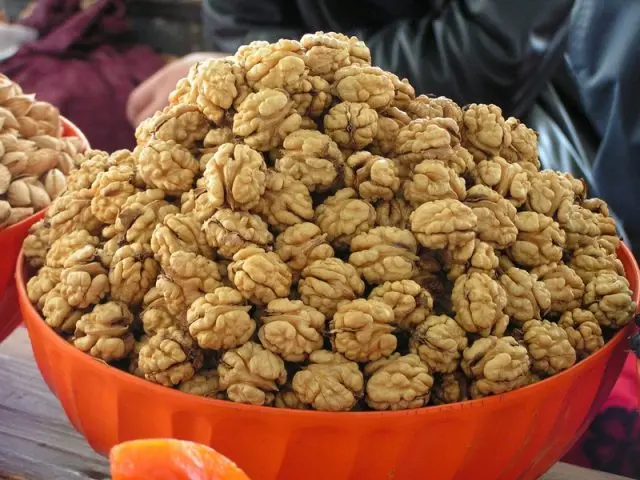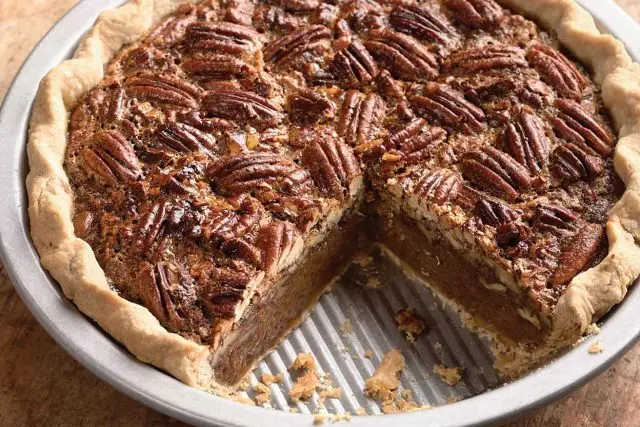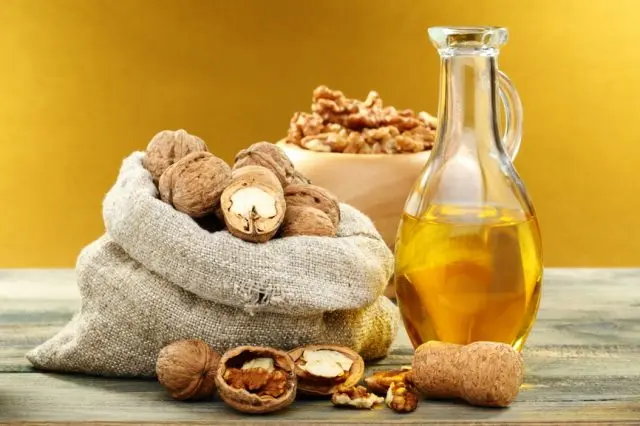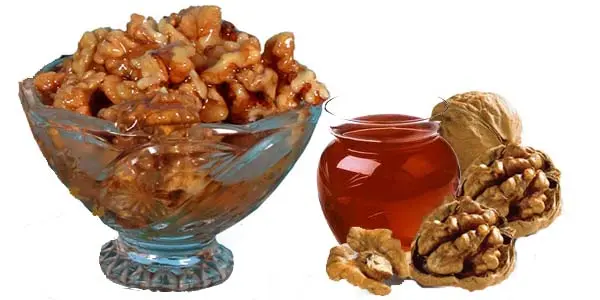Contents
If a woman after childbirth decides to breastfeed her baby, then her diet must be consistent with the needs of the child. And asking herself whether it is possible to eat walnuts while breastfeeding, a woman asks an important question. After all, what an adult can do is not always suitable for a baby, since his body is not yet able to cope with many elements in food, while in an adult these substances are excreted from the body in a natural and imperceptible way.
Is it possible for a nursing mother walnuts
During lactation, a woman is obliged to think, first of all, about her child when she eats something. The body of a nursing mother must be carefully protected from many harmful foods, drugs and alcohol. Everything that the mother eats passes to the child through milk, which provides the body of the newborn with useful microelements. Since the child does not yet have full-fledged immunity, and he receives body protection from his mother with milk, his organs are very susceptible to various changes in a woman’s diet.
When asked if walnuts can be breastfed, it is worth noting that this is one of the most harmless and healthy products. According to Dr. Komarovsky, during lactation, you do not need to limit yourself to any products, the main thing is that it gives joy and good mood to the mother.
The benefits and harms of walnuts when breastfeeding a newborn
Walnut itself is a very high-calorie product, despite the fact that carbohydrates in it are minimal. The bulk of the calories come from fats. When a child is not gaining weight well, the mother needs to increase the fat content of the foods that make up her diet. Walnuts create additional fat content for breast milk, while excluding fatty foods saturated with harmful carbohydrates that are deposited on a woman’s waist.

Another significant benefit of the royal tree kernels is that, by increasing the fat content of the diet, they affect the normalization of stool in the mother and newborn. If the child suffers from constipation, the mother should start eating a few walnuts a day, increasing the percentage of fat in breast milk.
The core also contains ascorbic acid, which is necessary in winter to prevent colds and viral diseases. Acid strengthens the walls of blood vessels. This is especially important for those women who suffer from headaches and other cardiovascular diseases.
The energy value of the product is 648 kcal per 100 g, 547 of them belong to the fat part, the rest are proteins and carbohydrates. The nut contains:
- 10,2 g carbohydrates;
- 15,4 g protein;
- 65 g fat;
- beta-carotene;
- vitamins A, B2, B2, B5, B6, B9, C, E, K, H, PP;
- potassium, calcium, zinc, magnesium, manganese, selenium, copper, phosphorus, iron, sodium;
- alkaloids;
- tannins;
- omega-3 fatty acids.
Walnut also has contraindications. If a woman suffers from any type of colitis, gastrointestinal diseases, hypertension, or allergic reactions to foods, then she should eat this product very carefully, since her child may also have an allergy.
walnuts for lactation
Some women develop type 2 diabetes after the birth of a child, the so-called gestational diabetes. This type of diabetes is curable. Over time, following proper nutrition and lifestyle, a woman can get rid of it. One way to lower blood sugar without harming your baby is to eat walnuts. This is one of its main functions – lowering glucose in the body.

Another property of the fetus is the normalization of blood circulation in the brain, which is necessary for women suffering from headaches. Walnuts can be taken when breastfeeding in an amount of not more than 5 pieces per day, so as not to cause the opposite effect, not to provoke an allergy. The female body after childbirth is very sensitive to changes in nutrition and to any external influence.
There is one misconception among nursing mothers that during feeding, the product increases milk secretion, causing mastitis. In fact, it does not affect the level of milk production at all, but only its saturation with calories.
How much walnuts can you eat while breastfeeding
Since the walnut is considered an allergen, if a woman has previously infrequently eaten it, then starting with a large amount is not recommended. The body must get used to small doses, and it is also necessary to look at the reaction of the child to this product. If a child has redness or a rash on his body, especially between the folds of the skin and on the cheeks, then you should think about the fact that the baby has intolerance to some of the foods in the mother’s diet.
It is possible to understand whether it is worth eating walnuts for a nursing mother only after two weeks of taking it in small doses, no more than three kernels a day. If after 2 weeks of feeding the child did not show any symptoms of intolerance, then you can increase the dose to 5 pieces per day, as this is the daily norm for a healthy body. If a woman after childbirth has gained a lot of weight and is obese, then the intake of walnuts should be minimized due to the high calorie content of the product.

In what form is it better to use walnuts with HB
If a breastfeeding woman decides to introduce walnuts into her diet and wonders in what form she can eat it, then the answer is obvious – in the one in which she herself likes it. Some people cannot stand the taste of walnut kernels due to their specific viscosity in the mouth, but they understand the benefits of the product and do not want to give it up. As an alternative, you can use walnut in the form of oil. It is widely available in supermarkets, but few people pay attention to it. It is not cheap, its price for 500 ml is about 600 rubles. Add it to vegetable salads as a dressing. One teaspoon of oil replaces the daily norm of the product.

Walnut can be added to cereals along with dried fruits, rubbed into powder with a blender and added to a salad. It is not worth frying them during lactation. Fried in itself is harmful, and roasted nuts still lose their healing properties when exposed to heat.
To please a nursing mother with sweets with the help of walnuts after childbirth, while eliminating unhealthy sugar, you can crush the kernel and mix it with viscous or liquid honey. This recipe is very useful for colds. If honey is candied and there is no other in the house, it should not be melted, warmed honey loses vitamins.

Allergy to walnuts in babies
If the mother has not previously had a nut allergy, and the baby has one, then the best way to help the child is to refuse any products containing the component, including pastries with nuts, gozinak, and continue to breastfeed. The mother’s immunity will help the child cope with the disease.
Symptoms for diagnosing an allergy in a child to a walnut are as follows:
- rash;
- blisters;
- lacrimation;
- stuffy nose;
- cough;
- breathing difficulties;
- diarrhea or constipation;
- flatulence;
- swelling of the face;
- anaphylactic shock.
If any symptom is found, you should consult a doctor immediately, and remove from the diet not only walnuts, but also the following foods:
- seeds;
- soy products;
- lentils;
- beans;
- cashew;
- pistachios;
- sauces and ketchups;
- mustard.
These foods are not dangerous in and of themselves, but many people who are intolerant to the nut allergen do not react negatively to the listed foods either. And it is better for a nursing mother to play it safe by abstaining from this food for the duration of feeding.
Safety measures
In order to protect your child from an undesirable reaction of the body, you should remember if the woman herself had previously experienced intolerance to any product. If there was such a reaction, then by using a walnut during breastfeeding, you can harm the newborn. As mentioned earlier, it is better to test for the compatibility of a nut with the body by introducing small doses of this product into the diet. An allergy can occur to all types of nuts, including walnuts, or maybe only to some. If a woman had an intolerance to peanuts, then it is not certain that there will be the same reaction to walnuts. Usually, allergy sufferers cannot even touch the allergen with their skin or inhale the dust from the husk.
Противопоказания
Despite the huge benefits of walnuts, it has a number of contraindications. In addition to allergy sufferers, the product should not be taken by women suffering from:
- diseases of the pancreas;
- skin diseases (psoriasis, neurodermatitis, eczema);
- high blood clotting;
- high blood pressure;
- obesity 2-4 degrees.
All these contraindications apply only to the mother, the child can only suffer from an allergy to any of the components included in this product.
Conclusion
Walnuts during breastfeeding should not be singled out as risky or, conversely, very important products. Any food must be taken in moderation, avoiding abuse. When choosing products after childbirth, you need to listen to your body, paying attention to your desires and reactions to a particular product.









